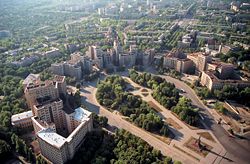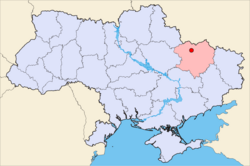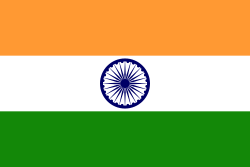Kharkiv
| Kharkiv (Харків) Kharkov (Харьков) |
|||
 |
|||
|
|||
 |
|||
| Coordinates: | |||
| Country | |||
|---|---|---|---|
| Oblast | Kharkiv Oblast | ||
| Raion | Kharkivskyi Raion | ||
| Founded | 1654 | ||
| City rights | 1552-1654 | ||
| Government | |||
| - Mayor | Mikhail Dobkin | ||
| Area | |||
| - Total | 310 km² (119.7 sq mi) | ||
| Elevation | 152 m (499 ft) | ||
| Population (2007) | |||
| - Total | 1,461,000 | ||
| - Density | 4,500/km² (11,654.9/sq mi) | ||
| Time zone | EET (UTC+2) | ||
| - Summer (DST) | EEST (UTC+3) | ||
| Postal code | 61001—61499 | ||
| Licence plate | ХА, 21 (old) | ||
| Sister cities | Belgorod, Bologna, Cincinnati, Kaunas, Lille, Moscow, Nizhny Novgorod, Nuremberg, Poznań, St. Petersburg, Tianjin, Kutaisi, Varna | ||
| Website: http://www.city.kharkov.ua | |||
Kharkiv (Ukrainian: Харків),[1] also called Kharkov (from Russian: Харьков) is the second largest city in Ukraine. It was the first capital of Soviet Ukraine, now the administrative center of the Kharkiv Oblast (province), as well as the administrative center of the surrounding Kharkivskyi Raion (district) within the oblast. The city is located in the northeast of the country. As of 2006, its population is 1,461,300.[2]
Kharkiv is one of the main industrial, cultural and educational centres of Ukraine. Its industry specializes mostly in arms production and machinery. There are hundreds of industrial companies in the city. Among them are world famous giants like the Morozov Design Bureau and the Malyshev Tank Factory, leaders in tank production since the 1930s; Hartron (aerospace and nuclear electronics); and the Turboatom turbines producer.
There is also an underground rapid-transit system (metro) with about 35 km of track and 28 stations. A well-known landmark of Kharkiv is the Freedom Square (Ploshcha Svobody), which is currently the third largest city square in Europe, and the 7th largest square in the world.
Contents |
Geography and climate
Kharkiv is located in the northeastern region of Ukraine at around . Historically, Kharkiv lies in the Sloboda Ukraine region (Slobozhanshchyna also known as Slobidshchyna), in which it is considered the main city. The city rests at the confluence of the Kharkiv, Lopan, and Udy Rivers, where they flow into the Northern Donets watershed.
Kharkiv's climate is moderate continental: cold and snowy winters, and hot summers. The seasonal average temperatures are not too cold in winter, not too hot in summer (-6.9 °C in January, and 20.3 °C in July). The average rainfall totals 513 millimetres per year, with the most in June and July.
| Month | Jan | Feb | Mar | Apr | May | Jun | Jul | Aug | Sep | Oct | Nov | Dec | Year |
|---|---|---|---|---|---|---|---|---|---|---|---|---|---|
| Ave. high °C (°F) | -5 (23) | -2 (27) | 2 (37) | 13 (56) | 21 (71) | 25 (77) | 27 (81) | 26 (79) | 20 (68) | 12 (55) | 3 (39) | -1 (30) | 12 (54) |
| Ave. low °C (°F) | -9 (15) | -8 (17 | -3 (26) | 4 (40) | 10 (50) | 13 (56) | 15 (59) | 14 (58) | 9 (49) | 3 (39) | 0 (31) | -3 (25) | 3 (39) |
| Source: Weatherbase[3] | |||||||||||||
History
Archeological evidence discovered in the area of present-day Kharkiv indicates that a local population has existed in that area since the 2nd millennium BC. Cultural artifacts date back to the Bronze Age, as well as those of later Scythian and Sarmatian settlers. There is also evidence that the Chernyakhov culture flourished in the area from the 2nd to the 6th century.
Founded in the middle of 17th century, the city has had a university since 1805. During the early years of the Soviet Union, Kharkiv was the capital of the Ukrainian Soviet Socialist Republic (from 1917–1934).

In the early 1930s, the Ukrainian famine (Holodomor) drove many people off the land into the cities, to Kharkiv in particular, in search of food. Some of them died and were secretly buried in one of the city's cemeteries. During April and May 1940 about 3,800 Polish prisoners of Starobelsk camp were murdered in the Kharkiv NKVD building, later buried in Pyatykhatky forest (part of the Katyn massacre).[4]
During World War II, Kharkiv was the site of several military engagements. The city was captured by Nazi Germany and its military allies, recaptured by the Red Army, captured a second time by the Nazis and then finally liberated on August 23, 1943. Seventy percent of the city was destroyed and tens of thousands of the inhabitants were killed. It is mentioned that Kharkiv was the most populated city in the Soviet Union occupied by Nazis, since in the years preceding World War II, Kiev was the smaller of the two by population.
Between December 1941 through January 1942, an estimated 30,000 people (mostly Jewish) were killed by the Nazis. They were laid to rest in one of the largest mass graves that is known as Drobitsky Yar.
During World War II, four battles took place for control of the city:
- Battle for Kharkov
- Struggle for Kharkov
- Kharkov offensive operation
- Operation Polkovodets Rumyantsev
Before the occupation, Kharkiv's tank industries were evacuated to the Urals with all their equipment, and became the heart of Red Army's tank programs (particularly, producing the legendary T-34 tank earlier designed in Kharkiv). These enterprises were returned after the war, and still continue to produce some of the world's best tanks.
Government and administrative divisions
While Kharkiv is the administrative center of the Kharkiv Oblast (province), the city affairs are managed by the Kharkiv City Municipality. Kharkiv is a city of oblast subordinance.
The territory of Kharkiv is divided into 9 administrative raions (districts):
- Dzerzhynsky (Ukrainian: Дзержинський район)
- Zhovtnevy (Ukrainian: Жовтневий район)
- Kyivsky (Ukrainian: Київський район)
- Kominternіvsky (Ukrainian: Комінтернівський район)
- Leninsky (Ukrainian: Ленінський район)
- Moskovsky (Ukrainian: Московський район)
- Frunzensky (Ukrainian: Фрунзенський район)
- Ordzhonikidzevsky (Ukrainian: Орджонікідзевський район)
- Chervonozavodsky (Ukrainian: Червонозаводський район)
Demographics
| Historical populations | ||
|---|---|---|
| Census | Pop. | %± |
| 1660 | ~1,000[5] | |
| 1788 | 10,742 (not children)[6] | |
| 1850 | 41,861[7] | |
| 1861 | 50,301[7] | |
| 1901 | 198,273[7] | |
| 1916 | 352,300[8] | |
| 1917 | 382,000[9] | |
| 1920 | 285,000 (Civil War)[8] | |
| 1926 | 417,000[8] | +20.85% |
| 1939 | 833,000[10] | +1.99% |
| 1.05.1941 | 902,312 (before World War II))[8] | |
| 09.1941 | ~1,400,000-1,450,000[11] | |
| 12.1941 | 456,639 (occupation, not children)[12][8] | |
| 23.08.1943 | ~170,000-220,000 (Liberation)[13] | |
| 1959 | 930,000[7] | +5.60% |
| 1962 | 1,000,000[7] | |
| 1.06.1976 | 1,384,000[7] | |
| 03.1982 | 1,500,000[6] | |
| 1989 | 1,593,970 | +1.67% |
| 1999 | 1,510,200 | -0.94% |
| 2001 | 1,470,900[14] | -0.97% |
According to the 1989 Soviet Union Census, the population of the city was 1,593,970. In 1991, the population decreased to 1,510,200, including 1,494,200 permanent city residents.[15] Kharkiv is currently the second-largest city in Ukraine after the capital, Kiev.[2]
The nationality structure of Kharkiv as of the 1989 census is: Ukrainians – 50.38%, Russians – 43.63%, Jews – 3%, Belarusians – 0.75%, and all others (more than 25 minorities) – 2.24%.[15]
The nationality structure of Kharkiv as of the 2001 census is: Ukrainians – 70.7%, Russians – 25.6%, Jews – 0.4%, Belarusians – 0.5%.[16]
Kharkiv's city residents are primarily Russophone.
Economy
During the Soviet Union times Kharkiv was the capital of industrial production in Ukraine and one of the largest centers of industry and commerce in the USSR. After the collapse of the Soviet Union the largely defense-systems-oriented industrial production of the city decreased significantly. In the early 2000s the industry started to recover and adapt to civil needs. Now there are more than 380 industrial enterprises concentrated in the city, which have a total number of 150,000 employees. The enterprises form machine-building, electrotechnical, instrument-making, and energy complexes.
State-owned industrial giants, such as Turboatom[17] and Elektrotyazhmash[18] occupy 17% of the heavy power equipment construction (e.g., turbines) market worldwide. Multipurpose aircraft are produced by Kharkov aircraft manufacturing plant of Antonov. Malyshev factory produces today not only armoured fighting vehicles, but also harvesters. Hartron[19] is the leading designer of space and commercial control systems in Ukraine and the CIS.
Education
Kharkiv is one of the most prolific centers of higher education and research of Eastern Europe. The city has 13 national universities and numerous professional, technical and private higher education institutions, offering students a wide range of disciplines. Kharkiv National University (12,000 students), National Technical University “KhPI” (10,000 students), Kharkiv National Aerospace University "KhAI" are the leading universities in Ukraine. A total number of 150,000 students attend the universities and other institutions of higher education in Kharkiv. About 9,000 foreign students from 96 countries study in the city. More than 17,000 faculty and research stuff are employed in the institutions of higher education in Kharkiv.
The city has a high concentration of research institutions, which are independent or loosely connected with the universities. Among them are three national science centers: Kharkіv Institute of Physics and Technology,[20] Institute of Metrology,[21] Institute for Experimental and Clinical Veterinary Medicine and 20 national research institutions of the National Academy of Science of Ukraine, such as Institute for Low Temperature Physics and Engineering.[22] A total number of 26,000 scientists are working in research and development.
In addition to the libraries affiliated with the various universities and research institutions, the Kharkiv State Scientific V. Korolenko-library[23] is a major research library.
Kharkiv has 212 schools. Among them are 10 lyceums and 20 gymnasiums.
Modern Kharkiv
Of the many attractions of the Kharkiv city are the: Gosprom (Derzhprom) building, Memorial Complex, Freedom Square, Taras Shevchenko Monument, Mirror Stream, Dormition Cathedral, Militia Museum, Intercession Cathedral, T. Shevchenko Gardens, funicular, Annunciation Cathedral, Children's narrow-gauge railroad and many more
Sport
Kharkiv is Ukraine's second largest city and as in the whole country sports are taken seriously. The most popular sport is football. The city has two clubs playing in the Ukrainian Premier League, one in the Persha Liha and one in Druha Liha B.
- Metalist Kharkiv, which plays at the Metalist Stadium
- FC Kharkiv, which plays at the Olypmiyskiy Stadium (Sumy)
- FC Helios Kharkiv, which plays at the Dynamo Stadium
- FC Arsenal Kharkiv, which plays at the Arsenal-Bavariya Stadium
Sister cities
Kharkiv is currently twinned with:[24]
 Bologna, Italy
Bologna, Italy Lille, France
Lille, France Nürnberg, Germany
Nürnberg, Germany Poznań, Poland
Poznań, Poland Cincinnati, United States
Cincinnati, United States Tianjin, China
Tianjin, China Bangalore, India
Bangalore, India
Nobel and Fields prize winners
- Vladimir Drinfeld (mathematics)
- Simon Kuznets (economics)
- Lev Landau (physics)
- Ilya Mechnikov (biology)
Famous people from Kharkiv
|
|
Transport

The city of Kharkiv is one of the largest transportation centers in Ukraine, which is connected to numerous cities of the world by air, rail and road traffic. The city has many transportation methods, including: public transport, taxis, railways, and air traffic.
Local transport
Being an important transportation center of Ukraine, Kharkiv itself contains many different transportation methods. Kharkiv's Metro is the city's rapid transit system, operating since 1975, it includes three different lines with 28 stations in total.[25] The Kharkiv buses carry about 12 million passengers annually, trolleybuses, tramways (which celebrated 100 years of service in 2006), and marshrutkas (private minibuses).
Railways
The first railway connection of Kharkiv was opened in 1869. The first train to arrive in Kharkiv came from the north on May 22, 1869, and on June 6, 1869, traffic was opened on the Kursk–Kharkiv–Azov line. Kharkiv's passenger railway station was reconstructed and expanded in 1901, to be later destroyed in the Second World War. A new railway station was built in 1952.
Various railway transportation methods available in the city are the: Railway trains, and elektrichkas (regional electric trains).
Air travel
Kharkiv is served by an international airport which used to have about 200 flights a day, almost all of them being passenger flights. The Kharkiv Osnova International Airport was only recently granted international status. The airport itself is not big and is situated within the city boundaries, south from the city centre. Flights to Kiev and Moscow are available on a daily basis. There are regular flights to Vienna and Istanbul, and several other destinations. Charter flights are also available. The former largest carrier of the Kharkiv Airport — Aeromost-Kharkiv — is not serving any regular destinations as of 2007. The Kharkiv North Airport is a factory airfield and was a major production facility for Antonov aircraft company.
Footnotes and references
- ↑ Britannica
- ↑ 2.0 2.1 "Results / General results of the census / Number of cities" (in English). 2001 Ukrainian Census. Retrieved on August 28, 2006.
- ↑ "Historical Weather for Kharkiv" (in English). Weatherbase. Retrieved on May 7, 2007.
- ↑ Fischer, Benjamin B., "The Katyn Controversy: Stalin's Killing Field", Studies in Intelligence, Winter 1999–2000, last accessed on 10 December, 2005
- ↑ Л.И. Мачулин. Тайны подземного Харькова. — Х.: 2005. ISBN 966-87-68-00-0
- ↑ 6.0 6.1 Харьков: Архитектура, памятники, новостройки: Путеводитель. Сост. А. Лейбфрейд, В. Реусов, А. Тиц. — Х.: Прапор, 1987
- ↑ 7.0 7.1 7.2 7.3 7.4 7.5 Н.Т. Дьяченко. Улицы и площади Харькова. - X.: Прапор, 1977
- ↑ 8.0 8.1 8.2 8.3 8.4 А.В. Скоробогатов. Харьков во время немецкой оккупации (1941-1943). - X.: Прапор, 2006. ISBN 966-7880-79-6
- ↑ А. Лейбфрейд, Ю. Полякова. Харьков. От крепости до столицы. - Х.: Фолио, 2004
- ↑ Государственный архив Харьковской области. Ф. Р-2982, оп. 2, дело 16, стр. 53-54
- ↑ Полковник Н. И. Рудницкий. Военкоматы Харькова в предвоенные и военные годы.
- ↑ По немецкой переписи декабря 1941; без детей и подростков до 16 лет; многие горожане уклонились от регистрации
- ↑ Н. С. Хрущёв. Донесение в ЦК ВКП(б) от 30 августа 1943. История: без «белых пятен». Харьковские известия, № 100—101, 23 августа 2008, стр.6
- ↑ Результаты Всеукраинской переписи населения 2001 года по Харьковской области
- ↑ 15.0 15.1 "Kharkov today" (in Russian). Our Kharkov. Retrieved on May 4, 2007.
- ↑ [Census 2001]
- ↑ turboatom.com.ua
- ↑ spetm.com.ua
- ↑ hartron.com.ua
- ↑ www.kipt.kharkov.ua
- ↑ metrology.kharkov.ua
- ↑ ilt.kharkov.ua
- ↑ korolenko.kharkov.com
- ↑ "Sister cities of Kharkov" (in Russian). kharkov.vbelous.net. Retrieved on May 4, 2007.
- ↑ "Metro. Basic facts" (in Russian). Retrieved on May 4, 2007.
External links
- General
- citynet.kharkov.ua — Official website of Kharkiv City Information Center
- city.kharkov.ua — Official website of Kharkiv City Council (Ukrainian)/(Russian)
- Kharkov city portal (Russian)
- Your beloved Kharkov — Kharkiv city portal
- KHARKIV ZA JAZZ FEST — official web-site of International kharkiv jazz festival KHARKIV ZA JAZZ FEST.
- gortransport.kharkov.ua — Transport in Kharkiv (Russian)
- Old Kharkov Gallery — Photos and postcards
- Maps
- karta.kharkov.ua — Interactive Map
|
||||||||||||||||||||
|
|||||||||||||||||


